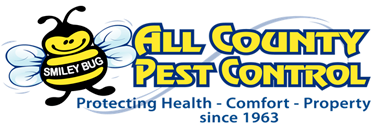In the late fall as temperatures drop it is not just humans that take to the indoors, squirrels, raccoons and opossums are likely to move indoors in preparation for the colder months. Unfortunately, our homes often provide the perfect shelter and warmth that these and other types of nuisance wildlife are looking for. Now is the time to inspect your home and look for obvious entry points and ways to reduce the risk of these vermin entering your home for the winter.
Once inside, wild animals are not only difficult to eradicate, but they can also pose serious health risks by carrying diseases like rabies and biting if they feel threatened. If you encounter nuisance wildlife on your property, it’s extremely important to contact All County Pest Control, instead of attempting to trap and remove the animal on your own.
- Screen vents: Raccoons and squirrels often find their way into homes via uncapped chimneys, broken vents and other openings along rooflines. Ensure that these items are fully screened to prevent wild animals from making your home their own.
- Cover the trash: Many types of nuisance wildlife, especially raccoons, are attracted to piles of trash left outside. You should store all garbage bags in plastic containers with sealed lids. Rodents such as mice and rats will love to feed on your garbage as well.
- Cut back vegetation: Squirrels and other small wildlife are known to use tree branches to gain access to rooflines, where they can then find a number of ways to move indoors. Be sure to cut back any tree limbs or branches that hang too close to the foundation. A good rule of thumb is to keep vegetation at least 12 feet from the roofline. Squirrels are very good jumpers.
- Clean up the yard: Do not leave brush, leaf piles or other debris accumulate in the yard in the fall waiting till spring will only give you problems all winter long., as these materials make the ideal harborage site for small animals. Also, make sure that firewood is stored at least 20 feet from the house during the cooler months.
- Keep bird feeders out of reach: Ensure bird feeders are only accessible by birds. Squirrels, raccoons, opossums and even bears are drawn to birdseed. Seed that makes it way to the ground offers an abundant food source for ground feeder, such as squirrels, mice and rats.

